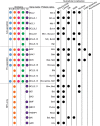Subcellular Localization and Dynamics of the Bcl-2 Family of Proteins
- PMID: 29497611
- PMCID: PMC5819560
- DOI: 10.3389/fcell.2018.00013
Subcellular Localization and Dynamics of the Bcl-2 Family of Proteins
Abstract
Bcl-2 family proteins are recognized as major regulators of the mitochondrial pathway of apoptosis. They control the mitochondrial outer membrane permeabilization (MOMP) by directly localizing to this organelle. Further investigations demonstrated that Bcl-2 related proteins are also found in other intracellular compartments such as the endoplasmic reticulum, the Golgi apparatus, the nucleus and the peroxisomes. At the level of these organelles, Bcl-2 family proteins not only regulate MOMP in a remote fashion but also participate in major cellular processes including calcium homeostasis, cell cycle control and cell migration. With the advances of live cell imaging techniques and the generation of fluorescent recombinant proteins, it became clear that the distribution of Bcl-2 proteins inside the cell is a dynamic process which is profoundly affected by changes in the cellular microenvironment. Here, we describe the current knowledge related to the subcellular distribution of the Bcl-2 family of proteins and further emphasize on the emerging concept that this highly dynamic process is critical for cell fate determination.
Keywords: Bcl-2 family; endoplasmic reticulum; mitochondria; nucleus; subcellular localization.
Figures



Similar articles
-
A Validated Set of Fluorescent-Protein-Based Markers for Major Organelles in Yeast (Saccharomyces cerevisiae).mBio. 2019 Sep 3;10(5):e01691-19. doi: 10.1128/mBio.01691-19. mBio. 2019. PMID: 31481383 Free PMC article.
-
Methods to Probe Calcium Regulation by BCL-2 Family Members.Methods Mol Biol. 2019;1877:173-183. doi: 10.1007/978-1-4939-8861-7_12. Methods Mol Biol. 2019. PMID: 30536006
-
Physiological and Pharmacological Control of BAK, BAX, and Beyond.Trends Cell Biol. 2016 Dec;26(12):906-917. doi: 10.1016/j.tcb.2016.07.002. Epub 2016 Aug 4. Trends Cell Biol. 2016. PMID: 27498846 Free PMC article. Review.
-
Apoptosis regulation at the mitochondrial outer membrane.J Cell Biochem. 2014 Apr;115(4):632-40. doi: 10.1002/jcb.24709. J Cell Biochem. 2014. PMID: 24453042 Review.
-
Effects of targeted Bcl-2 expression in mitochondria or endoplasmic reticulum on renal tubular cell apoptosis.Am J Physiol Renal Physiol. 2008 Mar;294(3):F499-507. doi: 10.1152/ajprenal.00415.2007. Epub 2007 Dec 26. Am J Physiol Renal Physiol. 2008. PMID: 18160625
Cited by
-
Sublethal cytochrome c release generates drug-tolerant persister cells.Cell. 2022 Sep 1;185(18):3356-3374.e22. doi: 10.1016/j.cell.2022.07.025. Cell. 2022. PMID: 36055199 Free PMC article.
-
A Rheostat of Ceramide and Sphingosine-1-Phosphate as a Determinant of Oxidative Stress-Mediated Kidney Injury.Int J Mol Sci. 2022 Apr 4;23(7):4010. doi: 10.3390/ijms23074010. Int J Mol Sci. 2022. PMID: 35409370 Free PMC article. Review.
-
The apoptosis inhibitor Bcl-xL controls breast cancer cell migration through mitochondria-dependent reactive oxygen species production.Oncogene. 2020 Apr;39(15):3056-3074. doi: 10.1038/s41388-020-1212-9. Epub 2020 Feb 17. Oncogene. 2020. PMID: 32066881
-
Differential dose-response effect of cyclosporine A in regulating apoptosis and autophagy markers in MCF-7 cells.Inflammopharmacology. 2023 Aug;31(4):2049-2060. doi: 10.1007/s10787-023-01247-4. Epub 2023 May 19. Inflammopharmacology. 2023. PMID: 37204695
-
Lipids modulate the BH3-independent membrane targeting and activation of BAX and Bcl-xL.Proc Natl Acad Sci U S A. 2021 Sep 14;118(37):e2025834118. doi: 10.1073/pnas.2025834118. Proc Natl Acad Sci U S A. 2021. PMID: 34493661 Free PMC article.
References
-
- Akao Y., Otsuki Y., Kataoka S., Ito Y., Tsujimoto Y. (1994). Multiple subcellular localization of bcl-2: detection in nuclear outer membrane, endoplasmic reticulum membrane, and mitochondrial membranes. Cancer Res. 54, 2468–2471. - PubMed
-
- Andreu-Fernández V., García-Murria M. J., Bañó-Polo M., Martin J., Monticelli L., Orzáez M., et al. . (2016). The C-terminal domains of apoptotic BH3-only proteins mediate their insertion into distinct biological membranes. J. Biol. Chem. 291, 25207–25216. 10.1074/jbc.M116.733634 - DOI - PMC - PubMed
-
- Arnaud E., Ferri K. F., Thibaut J., Haftek-Terreau Z., Aouacheria A., Le Guellec D., et al. . (2006). The zebrafish bcl-2 homologue Nrz controls development during somitogenesis and gastrulation via apoptosis-dependent and -independent mechanisms. Cell Death Differ. 13, 1128–1137. 10.1038/sj.cdd.4401797 - DOI - PubMed
Publication types
LinkOut - more resources
Full Text Sources
Other Literature Sources

